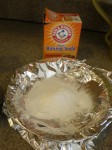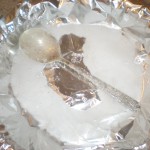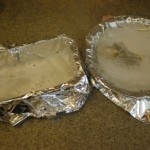The Hunt for Granny’s Silver
Our Project: Clean Granny’s Silver
No, we’re not polishing Granny’s silver tooth. We’re cleaning her tarnished silver for the traditional New Year’s black-eyed peas and collards dinner. (My husband’s family tradition for New Year’s is stuffed cabbage rolls, but that’s another story.)
Call me weird, but I like to polish silver. Every holiday I can remember, my mom would hand me a bottle of some pudding-like cleaner and a soft rag to wipe away the tarnish on her silver. Watching the shiny silver appear after a few swipes fascinated me.
Here’s how you can polish Grandma’s silver an easier way.
Our Tools:
a pan
aluminum foil
boiling water
baking soda (1 cup per gallon)
silver: silverware, silver bowels, silver serving platters (not silver teeth or silver jewelry)
Our Plan* (*adult supervision required)
- Line the pan with the aluminum foil. (The size pan depends on the size of the silver pieces you’re polishing.)
- Place the silver on the foil. Be sure each piece touches the silver.
- *Boil the water, then pour over the silver until it’s covered. (Adults must supervise.)
- Measure the baking soda and sprinkle into the water.
- Now watch ‘er work! If the solutions begins to bubble and spill, grab a towel and wipe before you have a bigger mess. The longer you leave the solution, the cleaner it will be. Or, sometimes you have to follow-up with the cleaning process twice to remove all the tarnish.
- Dry with a soft cloth and set the table for Grandma.
Voila! WHAT HAPPENED?
FIrst, the silver and the sulfur in the air mixed, resulting in the tarnished finish (black) on the silver. The tarnish is technically known as silver-sulfide.
Second, the cleaning solution created a chemical reaction between the aluminum and silver. The solution removed the electrons from the aluminum. When the silver and aluminum touches, there’s a small electric current as a result of the chemical (sodium bicarbonate) flowing. The charged atoms (electric current) remove the silver-sulfide from the silver and it sticks to the aluminum. This process is known to chemists as an electrochemical reaction.
Now, wasn’t that fun, simple, and interesting? So the next time you hear someone say chemistry, don’t start sweating and getting nervous. All you did was polish Granny’s silver and learned a little chemistry.
Reference: http://www.creativekidsathome.com/activities/science_experiment1.shtml








